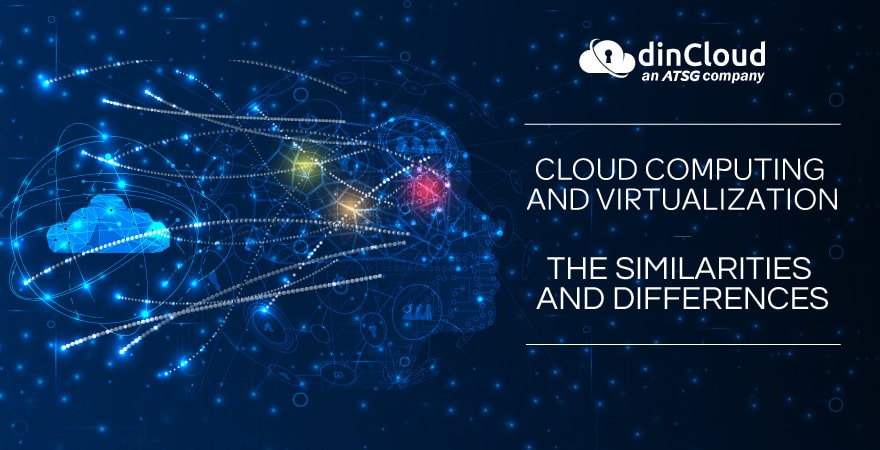When it comes to digital technologies, Cloud Computing and Virtualization are among the most important ones. Both these technologies have revolutionized enterprise workloads and the concepts of productivity in their own unique ways.
In this post, we will be discussing both Cloud Computing and Virtualization. Further, we will also delve into the similarities and differences between these technologies. Towards the end, we will discuss the importance of each in the enterprise world.

What is Cloud Computing?
Cloud Computing is the delivery of productivity resources such as desktops, software, development environments, databases, servers and more via the internet. The Cloud is all about consolidation and centralization of the above cited resources.
Related: Why are Small Businesses Investing Heavily in the Public Cloud?
Cloud services / resources can either be offered on a piece meal basis, for instance storage only. Otherwise, in most of the cases, Cloud Computing resources are offered in a combo, as only then are enterprises able to execute their workloads seamlessly.
The other good thing about most Cloud Computing environments is that the management of the entire cloud infrastructure is the domain of the Cloud Service Provider (CSP). The users simply access these resources, through the internet, and get their work done.
In exchange for cloud services / resources, the CSP charges the enterprise or users a fee, which can either be fixed or variable, depending upon the nature of the arrangement. Cloud solutions and services have gained rapid adoption over the past two years.
Related: Why & How are Enterprises Moving towards Green IT in 2022?
What is Virtualization?
The definition of virtualization is largely contained in the terminology itself. It is the conversion of computing resources into a software defined form. In fact, virtualization is the simulation of the things and tasks that an actual piece of hardware can perform.
Take the example of a traditional server, which exists in physical form. In its very basic state, there are a lot of limitations in terms of its use cases. Virtualization is capable of simulating all the functions this traditional server is capable of performing.
Furthermore, virtualization enables the interchangeable use of IT resources, whether its storage, processing or network etc. This empowers IT managers to use the same piece of hardware for a multitude of scenarios, as and when the needs change.
Related: The Transformation of Healthcare with Cloud Computing, AI and IoT
The Similarities b/w Cloud Computing and Virtualization
Instead of the word similarities, perhaps convergence would be a better explanation when outlining how both these technologies are similar. Interestingly, Cloud Computing relies heavily on Virtualization for delivery of the IT resources that it promises.
CSPs like dinCloud use virtualization technologies to create fully segregated computing environments within their high capacity data centers. This enables a dedicated environment for each user / enterprise, while using the same underlying hardware.
It will not be an overstatement that virtualization is the heart and soul of cloud computing services as well as solutions. Virtualization acts as the basic building block for cloud computing services and solutions.
Related: Global IT Spending to Grow by 5.1% in 2022 – Gartner Forecast
How are Cloud Computing and Virtualization Different?
It is less a matter of difference, and more related to the specific use case at hand. Virtualization delivers the software defined instances of IT resources in isolation, such as storage, compute or network etc.
Cloud Computing, on the other hand, involves software defined instances of Virtual Machines (VM), also called Cloud Hosted Virtual Desktops. The Cloud offers a full-stack of integrated components such as the Operating System (OS), storage, RAM and CPU etc.
With a Cloud Computing solution like a Cloud Hosted Virtual Desktop, or a Software as a Service (SaaS) offering such as a Customer Relationship Management (CRM) solution, a lot more can be achieved as compared to a single virtualized IT resource.
Head to Head b/w Cloud Computing and Virtualization
Virtualization is a very resource intensive undertaking, requiring substantial investments in both hardware resources and the rightly skilled professionals. Things get even more complicated once we factor in the limited scope of usability in the case of virtualization.
Cloud Computing, on the other hand, is a much more versatile domain with no entry barriers cited above in the case of virtualization. Most cloud computing solutions and services are offered by specialized service providers, with no hardware involved.
Instead, most cloud services are offered as per a subscription based model, in which all the underlying resources are procured and managed by the Cloud Service Provider (CSP). A subscription based model also makes the de-provisioning of cloud services a lot easier.
Conclusion
In the end, what we can conclude is that Virtualization is one of the key enablers of Cloud Computing solutions and services. However, Cloud Computing is something much bigger, and wholesome as compared to virtualization.
Cloud services and solutions have proved instrumental in the wake of a devastating and disruptive global pandemic for the last two plus years. Having said that, it all would not have been possible without virtualization.
Contact dinCloud, an ATSG company, for cloud computing solutions and services that are secure, reliable and cost efficient.


